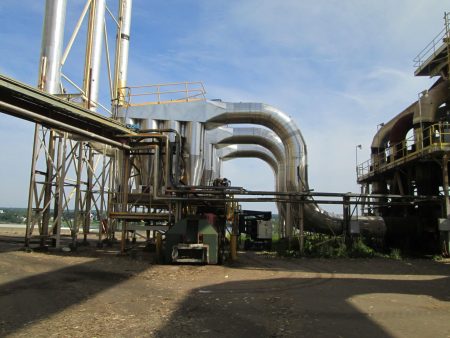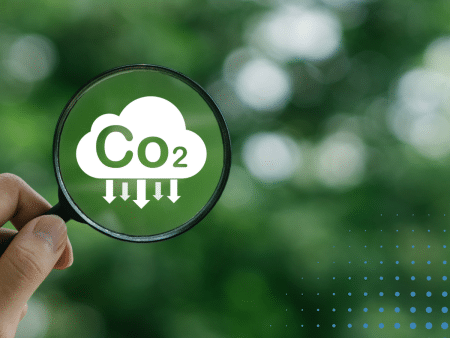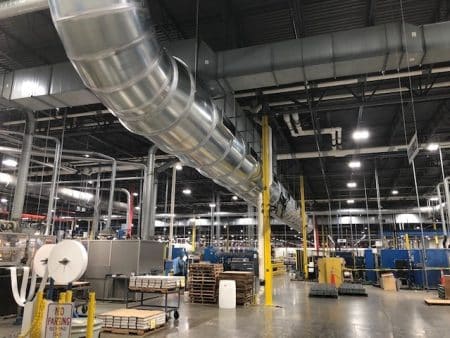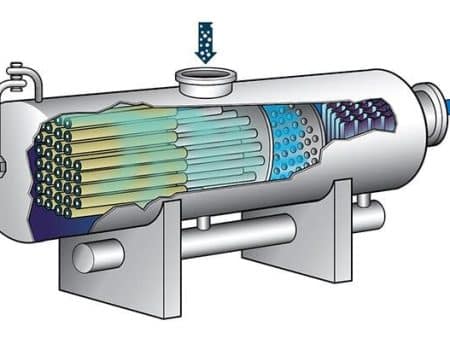Wet scrubbers are an effective technology for the control of harmful airborne pollutants and odors in process exhaust streams…
Introduction to Industrial Scrubbers
If you are a plant manager, a process engineer, or a purchasing or Environmental Health and Safety (EHS) professional who works in industrial manufacturing or the wastewater treatment industry, then you may be seeking a solution to remove harmful pollutants and odors from your process exhaust streams before they are released into the atmosphere and contaminate the outside air. One technology worth strong consideration is the industrial scrubber.
Industrial scrubbers are pollution filtration systems that utilize solids (in “dry scrubbers”), or water or other liquids (in “wet scrubbers”) to remove gas pollutants and odors from exhaust streams. In general, the main advantages of industrial wet and dry scrubbers to clean gas exhaust streams include:
- Low-risk processing of incendiary gases
- Ability to handle high-temperature, high-humidity gas streams without temperature limit or condensation problems
- Small space requirements mean lower capital costs and site location flexibility – scrubbers reduce the temperature and volume of unsaturated exhaust streams, permitting vessel sizes, fans and ducts to be more compact. This also enables retro-fitting into existing systems
- No secondary dust sources – once particulate matter is collected, it cannot escape from hoppers or during transport
- Ability to absorb gas and solid particulate matter via a single device
- Ability to neutralize corrosive gases
Dry Vs. Wet Scrubbers
Industrial scrubbers are categorized as either “dry” or “wet”. It’s important to understand the differences between wet vs. dry scrubbers. Dry scrubbers generally cannot achieve the same level of pollutant removal as wet scrubbers, but they are well-suited for applications in facilities that lack the infrastructure to properly handle produced wastewater.
Dry scrubbers remove pollutants from exhaust gases without the use of liquids. Instead, they utilize a dry reaction material known as “sorbent”, such as alkaline slurry, and they are primarily implemented for removal of acid from gas by moving the gas through the sorbent “dust” to maximize binding.
In contrast to dry scrubbers, wet scrubbers move contaminated gas through a liquid that is designed to remove pollutants. Wet scrubbers constitute a versatile and cost-effective pollution control technology that can eliminate more than 99% of airborne particulate matter.
How Wet Scrubbers Work
Water is the most common solvent used to remove inorganic contaminants. In the most basic form of wet scrubbers, water is encapsulated in a metal or composite container, contaminated gas is moved through the water, the water then absorbs the contaminates, and clean gas exits the scrubber.
Aside from water, other liquids can be used as absorbing solutions to effectively remove varied contaminates. Manipulating the chemical composition of the absorbing solutions changes the overall charge, which can be highly positively charged, negatively charged, or non-charged. Because pollutants differ in their charge, wet scrubbers are packed with the liquid that will bind most effectively to remove the contaminate from the gas. Caustic solution (sodium hydroxide, NaOH) is the most common scrubbing liquid used for acid-gas control (e.g., HCl, SO2, or both), though sodium carbonate (Na2CO3) and calcium hydroxide (slaked lime, Ca[OH]2) are also used.
Wet Scrubbing of Particulate Matter
Wet scrubbers can remove particulate matter by capturing them in liquid droplets. The droplets are then collected, with the liquid dissolving or absorbing the pollutant gases. Any droplets that are in the scrubber inlet gas must be separated from the outlet gas stream using a mist eliminator. Also, the resultant scrubbing liquid must be treated prior to any ultimate discharge or being reused in the plant.
A wet scrubber’s ability to collect particulate matter is often directly proportional to the power input into the scrubber. Additionally, a properly designed and operated mist eliminator is important to achieve high removal efficiencies.
If the gas stream contains both particulate matter and gases, wet scrubbers are generally the only single air pollution control device that can remove both pollutants.
Packed-Bed Wet Scrubbers
Wet scrubbers that remove gaseous pollutants are referred to as absorbers. Good gas-to-liquid contact is essential to obtain high removal efficiencies in absorbers. Various wet-scrubber designs are used to remove gaseous pollutants, with one of the most popular sub-categories of wet scrubber known as Packed-Bed, Packed-Tower, or “acid gas” (when they are used to control inorganic gases).
Although they can also collect solid particulate matter, Packed-Bed scrubbers are generally used more for the treatment of gas. Packed-bed scrubbers are typically used in the chemical, aluminum, coke and ferroalloy, food and agriculture, and chromium electroplating industries, in acid plants, fertilizer plants, steel mills, and asphalt plants.
Applicable Pollutants for Packed-Bed Wet Scrubbers
Packed-Bed wet scrubbers are used to control:
Inorganic fumes, vapors, and gases (e.g., chromic acid, hydrogen sulfide, ammonia, chlorides, fluorides, and SO2) – Inorganic fumes, vapors and gases are the primary pollutants controlled by Packed-Bed wet scrubbers. They typically achieve removal efficiencies in the range of 95-99%.
Volatile Organic Compounds (VOC) – Wet scrubbers are occasionally used to control volatile organic compounds (VOCs). Removal efficiencies for gas absorbers vary for each pollutant-solvent system and with the type of absorber used. Most absorbers have removal efficiencies in excess of 90%, and packed-tower absorbers may achieve efficiencies greater than 99% for some pollutant-solvent systems. The typical collection efficiency range is from 70% to greater than 99%.
Particulate Matter (PM) and Hazardous Air Pollutants (HAP) in particulate form (PMHAP) – Packed-bed wet scrubbers are limited to applications in which dust loading is low, and collection efficiencies range from 50-95 %, depending upon the application.
How Packed-Bed Scrubbers Operate
Packed-Bed scrubbers remove air pollutants through inertial or diffusional impaction, reaction with a sorbent or reagent slurry, or absorption into liquid solvent.
Packed-bed scrubbers consist of a chamber containing layers of variously-shaped packing material (e.g., spiral rings) that provides a large surface area for liquid-particle contact. The packing’s shape, weight, surface area and cost all influence the efficiency of the low gas-phase pressure drop and gas-liquid contact. The packing is held in place by wire mesh retainers, and is supported by a plate near the bottom of the scrubber.
Waste gas is forced into the bottom of the scrubber’s chamber and flows vertically or horizontally through the packing while scrubbing liquid is simultaneously and evenly introduced above the packing and flows down through the bed to coat the packing and establish a thin film. In vertical designs (packed towers), the gas stream flows up the chamber (“counter-current” to the liquid). However, some packed beds are designed horizontally for gas flow across the packing (“cross-current”).
The cleaned gas is then passed through a mist eliminator built into the top of the structure, and the waste slurry drops to the bottom of the chamber.
Advantages of Packed-Bed Wet Scrubbers
The advantages of Packed-Bed wet scrubbers are consistent with industrial scrubbers in general and include:
- Relatively low pressure drop – Pressure drop is the pressure difference that occurs as exhaust gas is pushed or pulled through the scrubber, disregarding the pressure that would be used for pumping or spraying the liquid into the scrubber.
- Fiberglass-reinforced plastic (FRP) construction permits operation in highly corrosive atmospheres
- Capable of achieving relatively high mass-transfer efficiencies
- The height and/or type of packing can be changed to improve mass transfer without purchasing new equipment
- Relatively low capital cost
- Relatively small space requirements
- Ability to collect Particulate Matter (PM) as well as gases
Classification, Categories and Types of Packed-Bed Wet Scrubbers
As wet scrubbers can vary considerably in their complexity and method of operation, creating standard categories into which all of them fit is challenging. Some people classify scrubbers for particle collection by the gas-side pressure drop of the system. However, most scrubbers operate over a wide range of pressure drops, depending on their specific application, thereby making this type of categorization difficult.
Other ways to classify packed-bed wet scrubbers are by their use – to primarily collect either particulates or gaseous pollutants, or by the energy source used for gas-liquid contact. At CECO Environmental, we classify packed-bed wet scrubbers in a variety of ways. One example is by design configuration. Whether horizontal or vertical, packed-bed wet scrubbers provide a reliable and practical means of removing acidic and caustic mists and gases from corrosive exhaust streams, with maximum efficiency and minimum pressure loss:
Wet Packed Bed Scrubber System, Horizontal
- Low profile design
- “Cross-flow” design
湿式填料床立式洗涤器系统
- “Counter-current flow” design
Other classification categories are by application:
烟气湿式洗涤器
- Fume and gas wet scrubbers are designed for most industrial air pollution applications, including scrubbing ammonia gas, chlorine gas, hydrochloric acid (HCL). They are especially effective on water-soluble fumes and odors.
- Fume and gas wet scrubbers are manufactured with premium materials and quality thermoplastic construction for maximum corrosion resistance, plus UV-resistant PVC, polypropylene and polyethylene available for all outdoor installations.
Packed-Bed Scrubbers for Municipal and Industrial Odor Control
- Offers great design flexibility
- Horizontal “cross-flow” designs and vertical “counter-current” designs
- 按需添加化学品可最大限度地降低运营成本
- 采用经济的方法以无限调节比处理大量的工艺空气,几乎适应所有化学选择
- 不会产生固体废物
氮氧化物控制湿式洗涤器
- High-efficiency wet oxidation/reduction approach to controlling nitrogen oxide (NOx) emissions
- Single and multiple stage systems can provide more than 99% efficiency total NOx removal and elimination of the red/brown NOx exhaust plume
- Minimal maintenance if thermoplastic construction is used for complete corrosion resistance
急冷洗涤器
- Two-stage scrubber solution for applications involving corrosive air from hot processes and corrosive air contaminants from processes such as thermal or catalytic oxidizers – HCl, HF, SO2, Cl2, HB
- 高效率——酸性或有毒气体的去除率高达99.9%
- 采用耐腐蚀和耐化学材料,可靠性和价值很高
- Two-stage system consists of:
- Quencher stage designed to cool the hot gases – constructed of a suitable metallic material
- Scrubber stage to remove the corrosive gases and mists – constructed of FRP material and is filled with a high efficiency packing material, mist eliminator and liquid distribution system
Venturi Scrubbers
Another popular type of wet scrubber is the Venturi scrubber. Venturis can be used to collect both particulate and gaseous pollutants, but they are more effective in removing particles than gaseous pollutants.
With Venturi scrubbers, the dirty gas entering a scrubber is forced at high velocity through a Venturi where it collides with scrubbing water. The tiny water droplets capture particles through impaction and diffusion. The mist eliminator for a Venturi scrubber is often a separate device called a cyclonic separator. The dirty water is then removed in the cyclonic separator and discharged into a recycle tank. Some of the liquid is continuously purged to limit the solids concentration and allow recirculation back to the Venturi section.
A Venturi scrubber typically consists of three sections:
- Converging section – Inlet gas stream enters the converging section and, as the area decreases, gas velocity increases. Liquid is introduced either at the throat or at the entrance to the converging section.
- Throat section – In the small throat section, the inlet gas is forced to move at extremely high velocities in the small throat section, and shears the liquid from its walls, producing an enormous number of very tiny droplets.
- Diverging section – in the diverging section, particle and gas removal occurs as the inlet gas stream mixes with the fog of tiny liquid droplets. The inlet stream then exits through the diverging section, where it is forced to slow down.
At CECO, we classify Venturi scrubbers a number of ways:
喷射式文丘里洗涤器
- Eductor scrubbers are designed to remove soluble gases and particulate by inducing a gas flow using high pressure liquid focused into a Venturi throat, which eliminates the need for a separate exhaust fan or blower to transport the contaminated gas stream to the filtration device.
- Design incorporates a high pressure spray for maximum entrainment and scrubbing efficiency, and is the optimal choice where high temperatures, heavy contaminant loads, and corrosive conditions are present.
- 最高效率 – 3微米或更大的气雾去除率高达99%
Wet Particulate Venturi Scrubbers
- Static pressure induced by an exhaust fan draws the sump water and dust-laden air stream into an inverted Venturi throat.
- Turbulent mixing of dust and small droplets form an agglomerate, which is returned to sump where water is reused and particulate matter settles out or is dissolved.
- Entrained mists and dust are collected on a chevron blade mist eliminator.
- The collected dust forms sludge at the conical bottom of the scrubber.
- 对极细颗粒物的效率超过99%
- 节能 – 无泵
- 维护节省 – 无移动部件、喷嘴或再循环管道
- 占地面积 – 高效的几何结构
- 节水 – 一体式节水污泥集中器,污水不需要稀释
- Ideal applications include:
- 铝、钛和其他金属加工操作
- 叠氮化钠推进剂的制造和处理
- 制药粉尘和粉尘
- 氯化钙粉尘
- 吸湿性粉尘
- 腐蚀性粉尘
- Food processing with Clean in Place (CIP) option
- 散装固体干燥工艺
- Battery lead pasting
High-Velocity Super Venturi Scrubbers
- 颗粒物收集和气体吸收的组合
- 垂直或水平气体入口
- 各种喉部设计和注水设计
- 整体或外部再循环罐
- Compact cyclonic separator design
- 高温淬火段
- 高固体浓度分离器设计
- 碳钢、不锈钢、镍合金或 FRP 结构
- 成套系统,包括储罐、泵、仪表、管道、风机、烟囱和控制装置
- Ideal applications include:
- 化学
- Food / Dairy Industry
- Paper
- Dryer
- 制药
- Roofing materials
- 沥青
- 采矿
- Steel
- Brick & Tile
- Fiberglass Insulation
- Power Generation
- Plastic Extrusion
Contact Us for Air Quality Improvement Solutions
To learn more about how wet or dry scrubbers may help solve your challenges, please visit our HEE-Duall brand (packed-bed scrubbers and Venturi scrubbers) and our Fisher-Klosterman brand (Venturi scrubbers). To learn more about all of the ways that CECO Environmental can help you grow your business while improving your air quality, please view this brief video. When it comes to controlling your industrial airborne pollutants, check out our variety of wet and dry scrubbers, and contact CECO. We have a solution for you.



